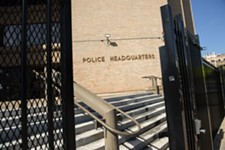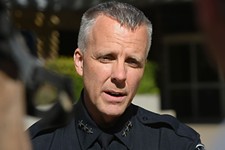Austin @ Large: The Real Race Problem
A cowardly city hides behind a dishonest daily's tall tales
By Mike Clark-Madison, Fri., Feb. 6, 2004

Let me start by saying, in this space, for (by my count) the sixth time in 18 months: The Austin Police Department has a race problem. It's a problem that can't be solved without dramatic change – not (or not only) on the street, but at the very top of the department and in the most rarefied echelons of City Hall. Chief Stan Knee and his top brass – and the commitment of the mayor, City Council, and city management team both to effective public safety and to social equity, which should be one and the same thing – are no longer trusted by the community, particularly the African-American community, or by the APD rank and file. Whether that lack of trust has "any basis in fact" or is "just a PR problem" is an irrelevant distinction – a police department that isn't trusted by the citizens it serves or by its front-line officers cannot do its job and is not worth the money spent on it. So Knee has to go, big changes need to be made, and City Hall and APD have to start from zero.
All of this was true before the Statesman's incredibly amateurish and reprehensible series last week on APD's use of force. Just as it did last year with its Barton Springs debacle, the daily played games with numbers it doesn't understand, pulled meaningless statistics out of its ass, claimed to have discovered hitherto unknown truths that simply don't exist, and contrived to tell its tall tales in the most outrageous (in the literal sense) and self-serving manner possible. And then, in the voice of Editor Rich Oppel, it pulled its usual Eddie Haskell: "We never said the cops were racist!" I don't even know how to be that sleazy. Perhaps Oppel can teach me, because he is, after all, a recognized leader in the profession.
So not only as a journalist, but as a citizen and human being, I am appalled. Yet, as a realist who knows political life is often far from righteous, I know it doesn't matter. Because the big story here is not that the Statesman told tall tales, but that City Hall went along with them. Last year, Toby Futrell and the City Council patiently, methodically, and more-or-less completely demolished the Statesman's falsehoods about Barton Springs being poisoned. This year, City Hall has meekly agreed with the daily's just-as-ridiculous conclusions about APD's use of force. Or, perhaps, has pretended to agree, because doing so helps serve City Hall's own political ends. Despite the expressions of pain and grief from Will Wynn and Futrell, the Statesman appears to have told them exactly what they wanted to hear.
Skewing the Numbers
In this issue, Jordan Smith does a detailed autopsy on the stinking corpse of the Statesman's APD series (see p.26), so only a few observations here. In some ways, the APD series was more prudent than the Statesman's Barton Springs hit job – there's no equivalent of the mythical coal-gas waste dump. But the statistical work at the core of the effort is even sloppier. You need to know something about how water quality is monitored to see what's wrong with the Statesman's Barton Springs analysis, but any clever high school math student can spot the really, really big flaws in the daily's "rate of force" calculations. The database of reports of APD use of force is not a valid, representative sample of the larger database of police contacts to which the Statesman compares it. So the daily's "rate of force" is a meaningless pseudo-actuarial statistic.
You could just as easily concoct a "rate of snakebite" to measure the likelihood that you or I or any other Austinite right now will be bitten by a rattlesnake. That chance is greater than zero for everyone, but it's a lot higher for people who happen to be walking in the tall weeds. If you only looked at people walking in the tall weeds – unless those people happened to be an accurate demographic sample of the city at large – your rate-of-snakebite stats would be seriously skewed.
And the chance of being met by police force is, theoretically, also greater than zero for all of us right now. But it's a lot, lot, lot higher for people who are getting arrested, and those people are clearly not an accurate demographic sample of the city at large. The vast disparities the daily found in use-of-force rates between the races are almost completely explained by the fact that African-Americans are, relatively speaking, far more likely to be arrested than whites, and police force, of any kind, is almost exclusively (nine out of 10 times) used when officers are attempting to arrest suspects. That's why APD compares its use-of-force data to arrests, not to contacts. Control the numbers for arrests, and the rate of force still shows statistical differences between the races that are worthy of public concern – but hardly shocking disparities whose exposure is worthy of a Pulitzer Prize.
Now, the fact that blacks are more likely to be arrested than whites is deplorable, but it's not unique to Austin or APD – it's true in almost every major American city, whether due to unfair racial profiling, historical and current social inequity, or both, or something else. None of those phenomena are reflected in the Statesman's analysis of this issue, on which the daily is suddenly so expert. Using the Statesman's methodology, you could also deduce an APD "rate of force" used against men that is many orders of magnitude greater than that used against women. Nobody would find this fact noteworthy, because we understand why this would be so – that there are other variables at play. There are likewise other variables at play here, ones that the Statesman could have easily accounted for in its analysis. The daily chose not to, and now pretends that because it doesn't know how to explain its own results, they must be true.
A Leadership Vacuum
But why have Will Wynn and Toby Futrell and (if only halfheartedly) Stan Knee all been willing to agree that the numbers must be true? City Hall – especially Futrell – is no doubt weary of repeated pissing matches with the Statesman (on the environment) and the Chronicle (on public safety). Since Knee, Wynn, and Futrell have all already acknowledged that APD has some sort of race problem, it may seem fruitless to quibble about the details.
But if you believe, as I believe, that Knee and his top brass, and to a degree City Hall, are the real source of APD's race problem – through their cowardice and lack of leadership – this explanation is less than satisfactory. The Statesman series – with its widely and aptly criticized mug shots of individual cops – has sent the message that APD's race problem originates not at the top but on the street, which is a convenient illusion for City Hall to embrace. Tweak the training, create some task forces, give the cops new, less-dangerous toys, levy some selectively harsh punishments on the rank and file, and this will all go away. You don't have to be at all sympathetic to the cop on the street to know that this is jive, and to their credit, APD's most vocal critics – the black ministers and the NAACP and the ACLU – have largely refused to take the bait.
I don't think it's any coincidence that City Hall's sticky embrace of the Statesman's findings comes right in the middle of contract negotiations with the Austin Police Association. The police union has become the villain in this saga precisely because it has accumulated so much power in recent years – thanks to the leadership vacuum at the top of the department. If APA President Mike Sheffield is really running the police department, it's because nobody else is. If the union has too much stroke, it's because City Hall has spent years pandering to conservative pro-cop voters by throwing money at APD without much caring how, and to what end, it gets spent. Instead of blaming the APA for being too effective in representing its members, we should be blaming City Hall and Knee for being too ineffective in representing the citizens at large. But until now, there has been no political upside for the City Council in asking tough questions about what kind of police department Austin wants and how we should devote resources to creating it.
Now, apparently, there is such an upside – it's more useful for City Hall to ally itself with APD critics than with APD defenders, even if it means swallowing the Statesman's findings without gagging. A better strategy, of course, would be for City Hall to show some leadership on the racial issues that Austin has so liberally and tolerantly swept under the carpet for years. Our city is terribly self-segregated; service delivery (both public and private) in communities of color is inadequate and in many ways getting worse; and opportunities for civic success, or even stability, that the Anglo majority (for now) takes for granted simply don't exist for other Austinites. We are, in short, a big American city, with unfortunately typical urban problems, of which APD's race problem is but one acute symbol. So far, neither City Hall nor APD have risen to the real challenge – and despite its posturing, the Statesman has made it easier, not harder, for the city to (so to speak) cop out. ![]()
For more on this story, see The Figures Do Lie.
Got something to say? The Chronicle welcomes opinion pieces on any topic from the community. Submit yours now at austinchronicle.com/opinion.








